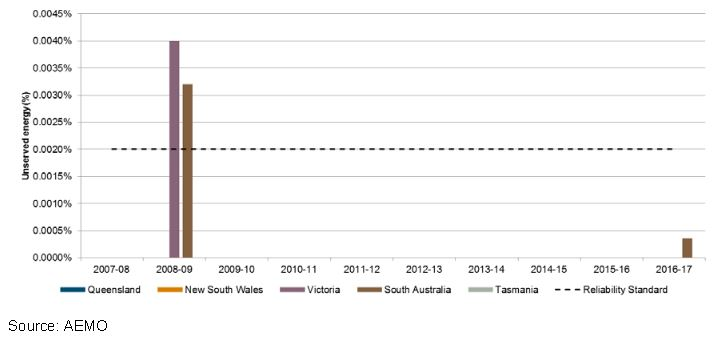NEM Reliability Review: Back to the future
The Reliability Panel of the Australian Energy Market Commission (AEMC) issued its latest market performance review earlier this week.
The report attracted attention particularly around the security of National Electricity Market (NEM) and the impact of an increase in renewables in the generation mix – the report found that there were 11 occasions when the power system operated outside its secure limits for more than 30 minutes and three times when frequency load shedding schemes were triggered in 2016-17. The AEMC’s chief executive Anne Pearson described the multiple times that the system dropped outside its secure limits as “particularly concerning”.[i]
Security of supply is unrelated to whether we have enough supply. Reliability provides insight into whether there is enough capacity – both generation and demand response – to meet customer demand in the NEM.
It’s clear from the AEMC’s assessment that we have enough generation capacity in the short and medium term. As firm, older coal-fired generation has retired there has been increased capacity installed via wind farms and solar PV. So the AEMC has reported on reduced system stability, while we have sufficient capacity and for this reason the AEMC’s Pearson said the report would surprise many.
Unique Year
When considering reliability the review found that 2016-17 was a “unique year” with unserved energy attributed to reliability recorded for the first time in any region since 2008-09.
While there was a single unserved energy event on 8 February[1] last year when 0.00036 per cent of energy demand was unmet in South Australia – still well within the reliability standard. The standard is set at 0.002 per cent of demand for energy being unmet, or at least 99.998 per cent of the forecast annual electricity demand is expected to be met by generation and interconnectors. The AEMC notes that historically there has been very little unserved energy in the NEM.
It does categorise the South Australian reliability incident as significant with the contributing factors of high demand, inaccurate forecasting of generation and load patterns and outages or limitations on older thermal plant
Aside from South Australia there was no unserved energy reliability event in any other NEM region and when it last occurred a decade ago, there was a significantly higher unserved level of energy in both Victoria and South Australia (see Figure 1) than in SA in 2016-17.
Figure 1: Unserved energy in the NEM - Reliability

To assess reliability the AEMC looks at:
- The unserved energy – this is the amount of customer demand that cannot be supplied within a region of the NEM because of a shortage of generation or interconnector capacity.
- Reserve levels – the spare capacity that is available to meet demand.
- The use of the Australian Energy Market Operators powers to direct and instruct market participants to maintain or return the system to a “secure, satisfactory or reliable operate state”.
As noted previously (RERT Locker, EnergyInsider 2 March 2018) it is more common for security events (disturbances in the transmission network) to lead to large scale blackouts, such as the September 2016 SA System Black and the January 2007 Victoria-NSW separation. Security events are unrelated to whether there is enough supply available. Dwarfing all blackout causes are localised issues in the distribution network. See figure 2.
Figure 2: Sources of Supply Interruptions in the NEM

Key Trends
Amongst the key reliability trends and outcomes, the Panel also noted:
- That lack of reserve level 3 notices[2] were issued for the first time since 2008-09. There were two LOR3 notices, the first time since 2008-09. Figure 3 shows the 22 LOR notices that were issues, the highest number since 2009-10. The greatest number of notices were issues during 2008-09 when there were 33. The AEMC cautions that the increase in LOR notices in 2016-17 is not sufficient to suggest that NEM reliability has materially worsened.
- During 2016-17 two directions to market participants were issued to maintain reliability – both occurred in South Australia – 9 February 2017 and 1 March 2017.
Figure 3: LOR Notices Issued in the NEM

The panel comments that there are various recent projects that would have an impact on NEM reliability. These are:
- The National Energy Guarantee.
- The Reliability Frameworks Review.
- A review of the reliability standard and settings.
Following the conclusion of the reliability standard and settings review, the Panel has proposed to leave them unchanged for the period 1 July 2020- 1 July 2024 because:
- The existing standard and settings are achieving their purpose and are likely to continue to do so.
- No change will ensure regulatory stability and benefit consumers and market participants.
- Matters relevant to other components of the broader market and regulatory frameworks for reliability are being considered through other proposals and reviews.
Security Comes To The Fore
The Review Panel noted that system security issues came to the fore in 2016-17. Key system security trends and outcomes highlighted by the Review Panel were:
- The amount of time outside of normal operating frequency band increased for the mainland NEM regions and decreased for Tasmania during 2016-17. As a general trend it found the number of normal operating frequency band exceedances has increased over the past three years for all NEM regions.
- In 2016-17 there were three instances where under frequency load shedding schemes were triggered.
- 11 instances of where the power system was not in a secure state for more than 30 minutes and over the past three years there has been an increase in these instances.
- Exceedance of secure voltage limits accounted for four of the above 11 instances.
- System restart ancillary services were called upon after the 28 September 2016 system black event in South Australia.
- AEMO issued eight power system directions.
[1] At 6pm on 8 February 2017 demand was higher than forecast, wind generation was lower than forecast and thermal generation capacity was reduced because of forced outages. Pelican Point notified AEMO that 165MW of capacity was unavailable.
[2] LOR3 is the highest level of notice and indicates that there is insufficient supply to meet demand. An actual LOR3 indicates load shedding.
[i] The Australian, 20 March 2018 “Renewables a threat to power security: report”.
Related Analysis
Retail protection reviews – A view from the frontline
The Australian Energy Regulator (AER) and the Essential Services Commission (ESC) have released separate papers to review and consult on changes to their respective regulation around payment difficulty. Many elements of the proposed changes focus on the interactions between an energy retailer’s call-centre and their hardship customers, we visited one of these call centres to understand how these frameworks are implemented in practice. Drawing on this experience, we take a look at the reviews that are underway.
Data Centres and Energy Demand – What’s Needed?
The growth in data centres brings with it increased energy demands and as a result the use of power has become the number one issue for their operators globally. Australia is seen as a country that will continue to see growth in data centres and Morgan Stanley Research has taken a detailed look at both the anticipated growth in data centres in Australia and what it might mean for our grid. We take a closer look.
Green certification key to Government’s climate ambitions
The energy transition is creating surging corporate demand, both domestically and internationally, for renewable electricity. But with growing scrutiny towards greenwashing, it is critical all green electricity claims are verifiable and credible. The Federal Government has designed a policy to perform this function but in recent months the timing of its implementation has come under some doubt. We take a closer look.
Send an email with your question or comment, and include your name and a short message and we'll get back to you shortly.



